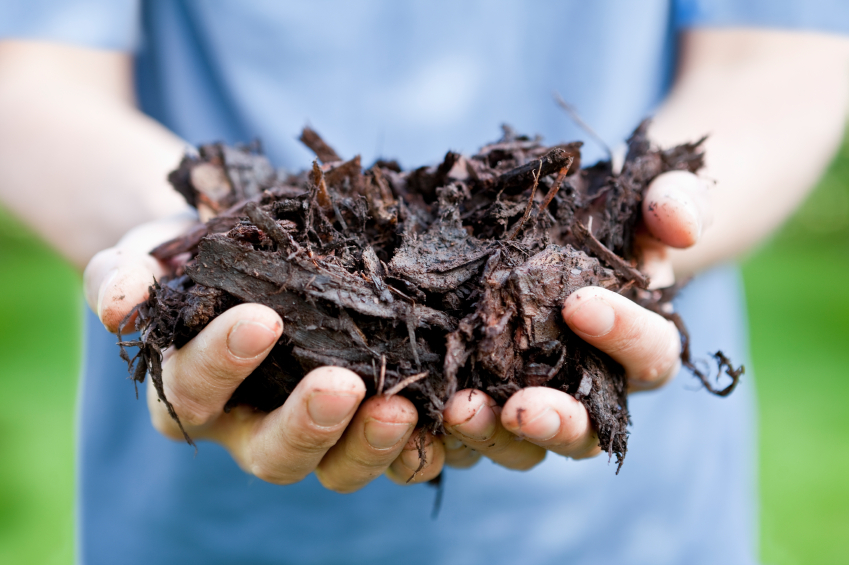To garden is to complain. Have you ever heard a gardener extol the virtues of the present weather? Instead, we wring our hands while grumbling about the lack or the abundance of rain. We whine that it’s too hot or too cold, that there aren’t enough sunny days or that the plants need respite from the incessant summer sun.
Soil fetches the greatest number of complaints: clay soil, we sob, is like gardening in cement, but sandy soil fails to hold water and nutrients. While we cannot do much about the weather, we can improve our soil.
The magic remedy is mulch. Many are the virtues of mulch: it retains moisture in the soil; it keeps roots cool in the summer and warm in the winter; and it cuts down on weed production. Best of all, mulch decomposes, thereby adding organic matter to the soil.
Now, “organic matter” is a panacea in the world of gardening. In fact, a true gardener will prattle on endlessly about organic matter, as this is the stuff that builds up a good growing medium in both sandy and clay soils. Compost is the ultimate organic matter, with mulch being a close second.
One of the first gardeners to extol the virtues of mulch was Ruth Stout, the sister of Rex Stout, the creator of Nero Wolfe, that rotund detective who pampered orchids on the side. Relishing gardening occasionally in the nude, Ruth extolled the virtues of using the “permanent mulch” that God gave us in the form of falling leaves. The Stout method included using any vegetation or garbage, excluding meat and inorganic material, as mulch. Ruth was onto something, even though some of her advice is best ignored, especially her insistence to mulch 10 to 12 inches in depth.
Mulches became popular when the Clean Air Act of 1972 forbade the lumber industry from burning its byproducts, such as pine bark. The choices in most communities are either hardwood or pine bark mulches, both of which come in a variety of sizes, some as small as one-quarter inch, others as large as three inches in diameter.
It is strictly a matter of preference which mulch to use. Some gardeners believe it takes more energy for the soil’s microorganisms to break down the hardwood mulch, whereas others turn their noses up at pine bark mulch. Both must be replenished — and this is good — because it’s through decomposition that the mulch turns into that magical “organic matter.”
The difference between compost and mulch is heat. In order to turn into lovely humus, compost must undergo a heat-fermentation process; mulch is the material that gardeners apply to the surface of the soil in order to retain moisture, to provide heat or cold protection, and to suppress weed growth. There are permanent inorganic mulches, such as stone, gravel, and tire pieces, and organic mulches, which derive from plant material. My suggestion is to avoid the inorganic mulches, as they do nothing for the soil.
It is always tempting to add sawdust to the soil, especially if you’ve just taken down a tree, but my advice is simple: don’t. While pine bark mulch breaks down relatively quickly, pine sawdust breaks down very slowly. This is because fresh sawdust and wood shavings contain such a high amount of carbon that the decomposition process ties up much of the nitrogen in the soil, leaving plants to starve. Forming an impenetrable mat, sawdust prevents water from trickling through the soil to get to the roots.
Besides sawdust, there are also some other organic mulches to avoid. Cocoa shells look attractive but are poisonous to dogs. Cypress mulches are best avoided because they retain a lot of water, thereby preventing the water from entering the soil, and cypress trees are not easily renewable. Grass clippings are best left on the grass to decompose, thereby nourishing the grass. Often they are filled with weed seeds, such as dandelions, buttercups, and crab grass, or have been treated with herbicides. Leaves make a lovely mulch — if they are chopped up either by a lawnmower or a leaf chopper. These chopped leaves will eventually turn into leaf mold, making you the envy of all the neighborhood gardeners.
Widely available in North Carolina, pine needles make an unsatisfactory mulch. In the first place, they are slow to decompose, they add acidity to the soil, and they deter earthworm activity. Earthworm activity is something gardeners never complain about. In the second place, the pine needles are not very attractive.
Generally, a good organic mulch needs to be spread once a year. No, it’s not a great deal of fun, but this is the easiest — and quickest — way to improve your soil. Just concentrate upon all the weed seeds you’re suppressing, all those roots you’re protecting, and all the water you are conserving. You might even contemplate following Ruth Stout’s example by mulching in the nude.









